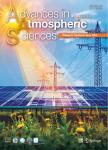A Deep Learning Method for Bias Correction of ECMWF 24–240 h Forecasts
A Deep Learning Method for Bias Correction of ECMWF 24–240 h Forecasts作者机构:College of Information Science and EngineeringOcean University of ChinaQingdao 266100China Institute of Urban MeteorologyChina Meteorological AdministrationBeijing 100089China Department of Electrical and Computer EngineeringColorado State UniversityFort CollinsCO 80523USA
出 版 物:《Advances in Atmospheric Sciences》 (大气科学进展(英文版))
年 卷 期:2021年第38卷第9期
页 面:1444-1459页
核心收录:
学科分类:07[理学] 0706[理学-大气科学] 0816[工学-测绘科学与技术] 0825[工学-航空宇航科学与技术]
基 金:supported in part by the National Key R&D Program of China (Grant No.2018YFF0300102) the National Natural Science Foundation of China (Grant Nos.41875049 and 41575050) the Beijing Natural Science Foundation (Grant No.8212025)。
主 题:numerical weather prediction bias correction deep learning ECMWF
摘 要:Correcting the forecast bias of numerical weather prediction models is important for severe weather warnings.The refined grid forecast requires direct correction on gridded forecast products,as opposed to correcting forecast data only at individual weather stations.In this study,a deep learning method called CU-net is proposed to correct the gridded forecasts of four weather variables from the European Centre for Medium-Range Weather Forecast Integrated Forecasting System global model(ECMWF-IFS): 2-m temperature,2-m relative humidity,10-m wind speed,and 10-m wind direction,with a forecast lead time of 24 h to 240 h in North China.First,the forecast correction problem is transformed into an image-toimage translation problem in deep learning under the CU-net architecture,which is based on convolutional neural networks.Second,the ECMWF-IFS forecasts and ECMWF reanalysis data(ERA5) from 2005 to 2018 are used as training,validation,and testing datasets.The predictors and labels(ground truth) of the model are created using the ECMWF-IFS and ERA5,respectively.Finally,the correction performance of CU-net is compared with a conventional method,anomaly numerical correction with observations(ANO).Results show that forecasts from CU-net have lower root mean square error,bias,mean absolute error,and higher correlation coefficient than those from ANO for all forecast lead times from 24 h to 240 h.CU-net improves upon the ECMWF-IFS forecast for all four weather variables in terms of the above evaluation metrics,whereas ANO improves upon ECMWF-IFS performance only for 2-m temperature and relative humidity.For the correction of the 10-m wind direction forecast,which is often difficult to achieve,CU-net also improves the correction performance.



